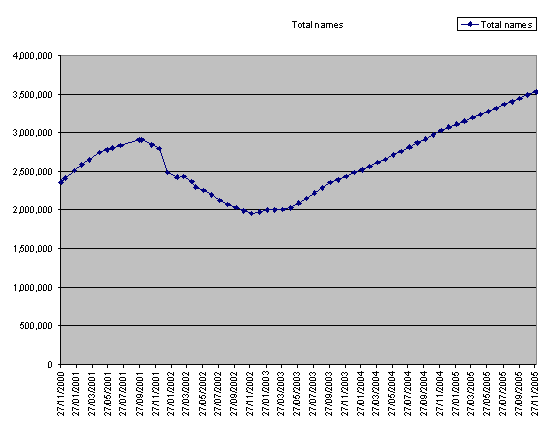C17. Technical plan for performing the Registry Function. This should
present a comprehensive technical plan for performing the Registry Function.
In addition to providing basic information concerning the proposed technical
solution (with appropriate diagrams), this section offers the applicant
an opportunity to demonstrate that it has carefully analyzed the technical
requirements for performing the Registry Function. Factors that should
be addressed in the technical plan include:
Scope
This section describes the comprehensive and professional quality technical
plan for transitioning and operating all aspects of the .org Registry Function.
It includes the technical requirement analysis, the detailed technical plan for
performing the registry function and the transition plan. It takes into account
the network and server hardware requirements and examines the resilience,
availability and costs associated with the technical continuity of service. .
Both Poptel and AusRegistry, the partners in Unity Registry, run successful
registries in the domain name system. The technical plan outlined here is based
on this extensive experience and is robust, scalable and maintainable. It is
fully conformant with all required technical standards and able to track the
development of relevant protocols.
The Scale of the Requirement
Before describing the system in detail it is useful to state Unity Registry’s
assumptions on the size of the registry and the number of transactions which it
will deal with.
Projections of Domain Name Registrations, Renewals and Register Totals
A set of full projections has been prepared covering the period May 2002 to
December 2005. The .org metrics data package supplied by VeriSign Global
Registry Services was used as the starting point for the projections and as this
was supplied under a non-disclosure agreement, we have not been able to refer to
specific data in this commentary.
The methodology used in preparing the projections is detailed in the
following paragraphs. All forecasts have been made on a prudent and conservative
basis.
New Registrations
Starting with the number of active registrations in the .org database as at
the end May 2002 (as opposed to the number of total registrations), we have
added a certain number of registrations per month for the months June 2002 –
December 2002. The number is based on the number of registrations made in .org
per month for the period January 2002 – April 2002 and it is assumed that new
registrations will remain at a similar level during the remainder of 2002.
Following the change of the registry operator and associated publicity and
marketing activities, we believe that the number of new registrations will
increase to 85,000 per month for the two years commencing in January 2003,
following which they will fall to an average level of 74,000 per month until
such time as market saturation is reached (outside the scope of this set of
projections).
It is believed that the .org namespace is sufficiently well established and
known as a brand not to be significantly affected by the new gTLDs. Of those
recently introduced, .info could be viewed as a direct competitor to .org and
.museum and .coop could appeal to sections of the .org market. However, it is
believed that the effect of these on the .org register will not be significant.
A number of the ccTLDs have established .org second level domains, the oldest
and most established of which is .org.uk, which currently has 233,000
registrations. It is believed that ccTLD impact upon the .org register will
continue to be minimal for the period of these projections.
Promotional Registrations
It is public knowledge that a large number of .org registrations were
provided free of charge during promotional activities and that almost all have
not been renewed. It is believed that the purging of these names will continue
until the end of the current year. Therefore, from the total in the register for
each month during the period June 2002 - December 2002, we have deducted a
percentage of the total registrations to make allowance for the promotional
names. It is assumed that all of these names will not renew and that all such
registrations will be purged from the register by the end of December 2002.
Renewals
The metrics package supplied the numbers of domain names due for renewal per
month and this information was built into the projections. Data was also
supplied concerning the number of registrations due for renewal where the names
had already been renewed on at least one occasion. For the purposes of the
projections, for the period June 2002 - April 2003, it was assumed that 60% of
those registrations would renew once more, a percentage that equates with
previous history. For the period May 2003 - December 2005, it has been assumed
that 40% of registrations that have renewed at least once previously will renew
again, a lesser percentage due to the uncertainty in the market and the relative
‘newness’ of these registrations.
There are a number of registrations that will fall due for renewal for the
very first time during the period of these projections, including names
registered for the first time following the change of registry operator. It is
assumed that only 40% of these registrations will renew, a percentage comparable
with .org historic information, and current gTLD and ccTLD renewal rates.
Capacity Planning
As the current registry holds an estimated 2.3 million database entries, it
is proposed to build the infrastructure to hold a minimum of 5 million
entries.
Estimated traffic to the registry database is around 13.5 million requests
per 24 hours, equating to 156 transactions per second on average. However, due
to the nature of the Internet and its usage, it is proposed that the
infrastructure must handle 500 transactions per second on average.
Names in the registry

Figure 1: projected total names

Figure 2: projected monthly renewals
|

